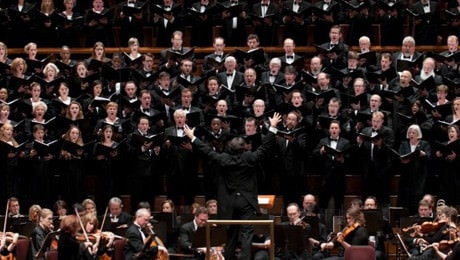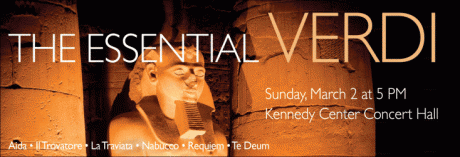The Washington Chorus, marking the 200th anniversary of Giuseppe Verdi’s birth with a series of concerts, offered the sixth on Sunday evening, with a program of arias, scenes and choruses from his most popular operas and liturgical music conducted by Music Director Julian Wachner, and featuring 10 accomplished soloists.
The concert opened with the storied “Va, pensiero” from Nabucco, a choral work that transcended its operatic origins to become, and remains, even now—just five years ago, an Italian senator proposed replacing the national anthem with it—a hymn of patriotism and liberation in Italy. While it was competently done, the dynamics correctly observed, the performance lacked the emotional component one might expect it to have in view of the work’s musical and historical context.
“La donna è mobile” from Rigoletto is another piece whose popularity has crossed musical and cultural borders, having been recorded by everyone from Luciano Pavarotti, to Alvin and the Chipmunks. (Plus some Scrubbing Bubbles). Placing anyone who attempts it implicitly up against some very . . . varied expectations. And tenor John McVeigh met most of the best of them, caressing and sustaining the G# in “muta d’accento,” ending the phrase in a fine diminuendo (a popular approach, though the score is marked forte, and there’s no fermata). In addition, McVeigh’s rakish demeanor was dramatically persuasive, helping carry the day at the end.
Introducing the “Libera me” from the Messa di Requiem, also known as the Manzoni Requiem, Wachner offered an affable but scholarly insight into the complicated genesis of the piece, originally composed as part of a collaborative effort of Italian composers, suggested by Verdi to commemorate the recent death of Gioacchino Rossini. Although the effort fell apart at the eleventh hour—“When you get a bunch of composers in a room . . .” observed the conductor drolly—Verdi continued with his own part of it, which five years later would become part of his own musical commemoration of the death of the writer and humanist Alessandro Manzoni.
As the “Libera me” began, the soprano, Corinne Winters, took full command, her voice clear and sure, the chorus, under Wachtner’s careful control, responding sotto voce in Verdi’s deceptively lulling echo, or—for those who know the work—breath-holding harbinger of what was to come. The harrowing “Dies irae” would not, however, come into its own until the recapitulation, when chorus and orchestra came together in terrifying unison, the timpani crashing with apocalyptic force, Wachner attentive and assertive as he swept them into compelling form, the chorus singly superbly and articulating the words with precision. Winters was especially effective in the concluding high B-flat, “Requi-em!”, the note soaring ethereally.

The mood was quickly broken—although, for some of us of an earlier generation, not without some of our synapses snapping—with another operatic popcorn favorite: The “Anvil Chorus” from Il trovatore, which was brought off enthusiastically, the singers, orchestra and conductor all getting into its steady, rhythmic pulse. It was followed (although not in the program) by a thrilling performance of Azucena’s fiery “Stride la vampa” by mezzo-soprano Ola Rafalo, whose imperious manner and dark, sultry chest voice, exploding in a ravishingly focused high G, captured the character’s passionate fury.
In another musical/emotional disconnect, this was followed by the “Sanctus” from the Requiem, then: a series of selections, choral and solo, from La traviata. The women seemed to enjoy singing the gypsy song, “Noi siamo zingarelle,” but it wasn’t exactly idiomatic in sensation—i.e., musical sensibility—or pronunciation. Corinne Winters returned for “Follie! Delirio vano è questo,” and did it well; though she didn’t milk it for its powerful emotional quotient the first time, she absolutely nailed it on the recapitulation, sailing the high E-flat out of the ballpark. (A magnificent tenor voice, which this writer later found out belonged to one Peter Scott Drackley, popped up in the chorus to respond as Alfredo in the “Sempre libera.”)
Wachtner, who seemed to enjoy educating the audience almost as much as conducting the chorus and orchestra, greeted us upon our return from intermission with a verbal précis on Verdi’s musical sophistication. Classical music instruction here being rooted in the Germanic musical tradition, we are trained to view the Italian—if only by dint of its not so being—as somewhat less significant, he said, then invited us to contemplate the fugual structure of Falstaff should we wish to rethink that assumption.
While Falstaff was not on the program, the “Te deum,” the fourth and final piece of Verdi’s Quatro pezzi sacri, was. Here the chorus and orchestra, in precise alignment, followed a barely audible sempre pp with a fortissimo eruption that fairly blew the rafters off the Concert Hall, the chorus following up with a positively (in both senses of the word) ear-splitting “coeli et terra maies-taaaaa-tis!”
The final selections of the evening were from Act 2, Scene 2 of Aida. The trumpet and flute soloists excelled in the Triumphal March, playing with verve and precision. Basso Peter Volpe was a richly voiced, solemn King, while baritone Stephen Salters was a lyrical Amonasro and tenor Isaachah Savage a stunningly dramatic Radames. Othalie Graham’s voice rang out in declamatory style as Aida. (As did her attire; her fire-engine-red gown with silver-studded bodice below a plunging, silver-framed neckline was a knockout). The chorus joined the six singers in a robust reading as the Act, and the concert, concluded.
The Washington Chorus: The Essential Verdi played on March 2, 2014 at The Kennedy Center’s Concert Hall—2700 F Street, NW, in Washington, DC. For future Kennedy Center events, check their performance calendar.





